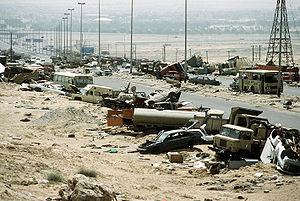
Back طريق الموت Arabic Шаша смерці Byelorussian ڕێگای مەرگ CKB Dálnice smrti Czech Highway of Death German Autopista de la muerte Spanish بزرگراه مرگ Persian Kuoleman moottoritie Finnish Highway of Death French Autocesta smrti Croatian
| Highway of Death | |||||
|---|---|---|---|---|---|
| Part of the Gulf War | |||||
 Wrecked and abandoned vehicles along Highway 80 in April 1991 | |||||
| |||||
| Belligerents | |||||
|
| |||||
| Commanders and leaders | |||||
|
| No Centralized Leadership | ||||
| Casualties and losses | |||||
| None |
| ||||
The Highway of Death (Arabic: طريق الموت ṭarīq al-mawt) is a six-lane highway between Kuwait and Iraq, officially known as Highway 80. It runs from Kuwait City to the border town of Safwan in Iraq and then on to the Iraqi city of Basra. The road was used by Iraqi armored divisions for the 1990 invasion of Kuwait. It was repaired after the Gulf War and used by U.S. and British forces in the initial stages of the 2003 invasion of Iraq.[5]
During the American-led coalition offensive in the Persian Gulf War, American, Canadian, British and French aircraft and ground forces attacked retreating Iraqi military personnel attempting to leave Kuwait on the night of February 26–27, 1991, resulting in the destruction of hundreds of vehicles and the deaths of many of their occupants. Between 1,400 and 2,000 vehicles were hit or abandoned on the main Highway 80 north of Al Jahra.
The scenes of devastation on the road are some of the most recognizable images of the war, and it has been suggested that they were a factor in President George H. W. Bush's decision to declare a cessation of hostilities the next day.[6] Many Iraqi forces successfully escaped across the Euphrates river, and the U.S. Defense Intelligence Agency estimated that upwards of 70,000 to 80,000 troops from defeated divisions in Kuwait might have fled into Basra, evading capture.[7]
- ^ a b Holsti, Ole R. (2011). "Prelude: The United States and Iraq before the Iraq War". American Public Opinion on the Iraq War. University of Michigan Press. p. 20. doi:10.3998/mpub.1039750. ISBN 978-0-472-03480-2. JSTOR 10.3998/mpub.1039750.6.
Air attacks inflicted heavy casualties on retreating forces along what became known as 'the highway of death.' American, British, and French units pursued the Iraqis to within 150 miles of Baghdad.
- ^ Taylor, Scott (2004). Among the Others: Encounters with the Forgotten Turkmen of Iraq. Esprit de Corps Books. p. 92. ISBN 978-1-895896-26-8.
Canadian CF-18 fighters based in Qatar were only equipped with air-to-air missiles, as their role was to provide rear area combat air patrols. However, upon hearing from allied pilots that there was a massive 'turkey shoot' taking place in Kuwait, unofficial arrangements were made to equip the Canadians with U.S. bombs.
- ^ Giordono, Joseph (February 23, 2003). "U.S. troops revisit scene of deadly Gulf War barrage". Stars and Stripes. Archived from the original on January 16, 2011. Retrieved July 27, 2009.
- ^ Tucker, Spencer C., ed. (2010). The Encyclopedia of Middle East Wars: The United States in the Persian Gulf, Afghanistan, and Iraq Conflicts: The United States in the Persian Gulf, Afghanistan, and Iraq Conflicts. Gale Virtual Reference Library. Vol. I. ABC-CLIO. p. 710. ISBN 978-1-85109-948-1.
- ^ Thompson, Mark (May 3, 2012). "Highway (of Death) Robbery". Time. Retrieved December 19, 2014.
- ^ Hersh, Seymour M. (May 22, 2000). "Overwhelming Force: What happened in the final days of the Gulf War?". The New Yorker. pp. 48–82. Retrieved January 3, 2021.
- ^ Cite error: The named reference
hammurabiwas invoked but never defined (see the help page).
© MMXXIII Rich X Search. We shall prevail. All rights reserved. Rich X Search